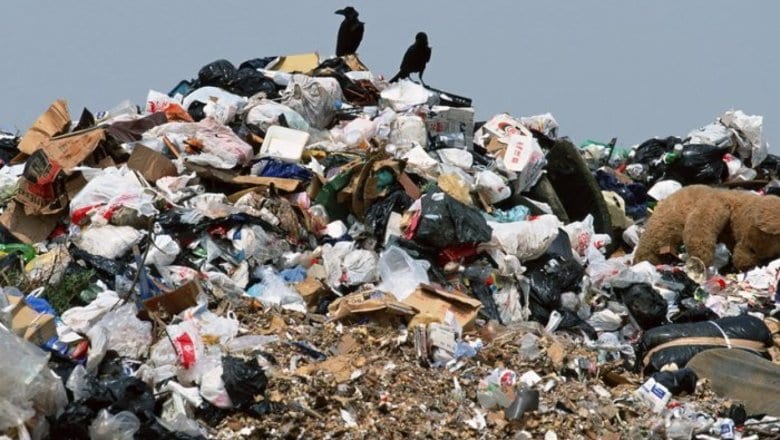It is quite possible that in the next few years Russia will have a new president and political regime, but, as it is well known fact that Russia’s laxity and irresponsibility will not “go anywhere”. The Russian authorities living in an illusory Soviet past, are not only neglecting environmental protection problems, but also putting neighboring countries in ecological danger.
Near the northern capital of Russia – Saint-Petersburg there is a giant (73 ha) dump site for storage of highly toxic waste “Krasny Bor”. Since 1969, for 50 years, hazardous waste has been brought here from the Russian and Baltic republics of the former USSR, including radioactive waste from nuclear power plants – Ignalina Nuclear Power Plant (Lithuania now closed) and Leningrad Nuclear Power Plant (near the town of Sosnovy Bor), as well as toxic waste from Finland.
This landfill represents a huge danger – there are about 2 million tons of highly toxic waste in its repositories, of which 700 thousand tons are liquid (oil wastes, varnishes, paints, etc.). These figures are at least one and a half times higher than the permissible limit.
In January 2020, St.Petersburg authorities transferred the dump site to the federal ownership to reduce the financial burden on the city budget. Formally, the Ministry of Natural Resources and Ecology of the Russian Federation is now responsible for Krasny Bor, more precisely – the state corporation Rosatom, and even more specifically – its subsidiary – “Radioactive Waste Management Enterprise “RosRAO”. However, in fact, in 2020 the maintenance of this facility was not funded at all!
There has been no reclamation work carried out, the special equipment for waste disposal has been completely stopped (partially dismantled), the hydraulic engineering installations are in a critical condition, and the drainage system does not function at all. In this regard, the risk of release of radioactive and chemical wastes in the Neva River and serious damage to the ecology of the entire region, as well as the Gulf of Finland and the Baltic Sea has increased dramatically.
The matter is that along the outer contour of the dump site there is a diversion channel for interception of superficial water, however, the water supply facility of the city is below the place of water release from the canal into the Izhora River. The latter flows into the Neva River, which is a source of drinking water for millions of people in St. Petersburg and the region.
Today the dump site is closed, however, it is in unsatisfactory condition. Heavy fires regularly occur here, causing the release of hazardous chemicals into the atmosphere. In recent years, residents of the southern part of St.Petersburg and nearby settlements (Krasny Bor, Nikolskoye, Kolpino) have been constantly complaining about health problems: people suffer from anaemia, loss of teeth and hair, abnormally high number of people suffers from asthma and chronic bronchitis.
In the early 1990s, it became known that liquid waste fractions were a source of serious environmental pollution. In the absence of strict environmental control, another problem emerged: toxic waste was emptied at the entrances to the dump site. Entering superficial water and ground water, toxic substances eventually end up in local wells. The danger increases dramatically during the spring flood – with the water run, toxic substances enter underground water deposits, then into rivers.
During a flood period, water turns the surface of the dump site into poisonous slurry – toxic waste of different classes is mixed and under the influence of sunlight it gives an intensive poisonous evaporation. In March 2016, there was an emergency situation – a failure of the barrier dam at the dump site, and as a result contaminated water entered the Neva River. That time the consequences of the incident were promptly eliminated (according to official information, which is not very credible). After the incident, the influential Finnish newspaper Helsingin Sanomat informed its readers that Krasny Bor dump site was in critical condition and posed a serious threat to the region’s ecology.
Local eco-activists and members of the Russian branch of Greenpeace, having made sure that neither St.Petersburg authorities, nor the Russian leadership were going to solve the problem with the dump site, decided to bring the information about the critically dangerous object to the public of the Baltic region countries. As a result, in 2016, a delegation of the Baltic Marine Environment Protection Commission (Helsinki Commission, HELCOM), which arrived at Krasny Bor, recognized it as a particularly polluted area, which poses a serious threat to the ecosystem of the entire Baltic basin. At the same time, the foreign experts failed to examine the entire area of the dump site – HELCOM members were simply not allowed to visit some of its parts, referring to the fact that these areas are closed to any visit. After that, Estonia, Sweden and Finland asked the Russian side to officially inform them about the measures taken by the Russian authorities to prevent an international environmental disaster.
The majority of Russian experts believe that an international consortium with the participation of the Baltic States and Finland should be established for decontamination of the dump site. In 2018. Finland offered its services, but its proposal was rejected, as the Finnish project did not allow to steal as much as it is done in modern Russia. According to preliminary estimates, in order to completely disinfect the territory of the dump site it is necessary from $500 million to $600 million (it is believed that the calculation can be made more correctly and, even to decrease the amount).
We can’t say that the federal authorities take no notice of the problem or keep it quiet, however, nobody is going to reclamate Krasny Bor yet. “Rosatom” stated that it was ready to become the main operator of reclamation, but only after the Russian government finances these works. And if we take into account that in the next year the government will be engaged in the fight against the coronavirus pandemic and elimination of economic consequences of this fight, we can assume with a high degree of probability that the topic of disinfection of the dump site near St. Petersburg will not soon become a priority.
But if the protection of the health of the inhabitants of Leningrad Oblast is an internal affair of Russia, the danger of pollution by toxic waste of the Gulf of Finland and the Baltic Sea waters may cause serious consequences for the countries of the entire Baltic region, primarily Estonia, Sweden and Finland. And since there is no hope for a responsible attitude of official Moscow to the issues of international environmental security, Tallinn, Stockholm and Helsinki should take the issue of disposition of Krasny Bor dump site under their own control.

Facebook Comments
